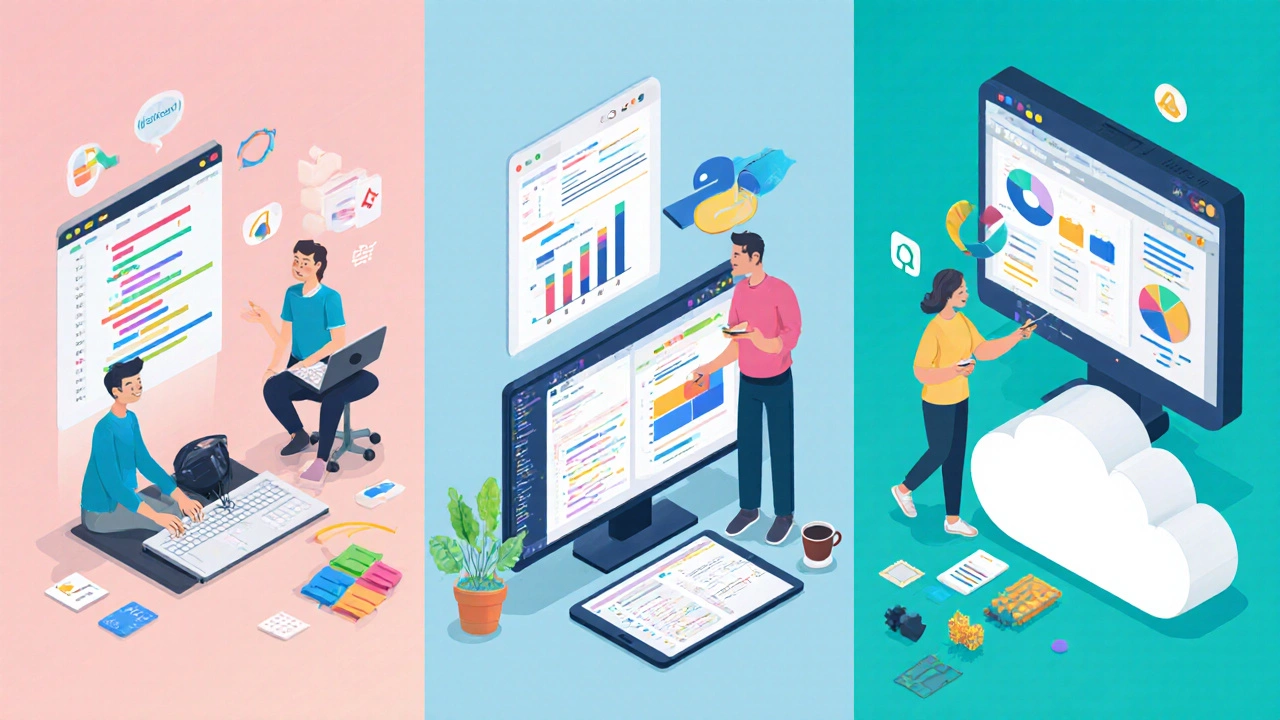3-Month Job-Skill Selector
Recommended Skill for You:
Learning Roadmap:
Quick Summary / Key Takeaways
- Focus on high‑demand tech and business skills that can be mastered in ~12 weeks.
- Choose a skill that matches local job market demand and your personal interests.
- Follow a structured learning roadmap: fundamentals → project → portfolio → certification.
- Leverage free resources, bootcamps, or short‑term certificates to prove competence.
- Tailor your resume, build a showcase project, and network actively to land interviews fast.
When you’re pressed for time, a 3‑month job‑ready skill is a focused learning block that equips you with the core abilities employers demand, often backed by a recognized certificate. The question most job‑seekers ask is: what can I learn in three months that will actually get me hired? Below you’ll find a step‑by‑step guide, a rundown of the top five fast‑track skills, salary snapshots, and practical tips to turn a short course into a full‑time offer.
How to Choose the Right 3‑Month Skill
Before you sign up for any program, run through these three decision filters:
- Job demand: Check regional job boards (Indeed, LinkedIn) for postings that list the skill as a required or nice‑to‑have qualification.
- Earned salary: Look at median salaries for entry‑level roles. A higher pay ceiling justifies the investment of time.
- Personal fit: You’ll spend 10‑15 hours a week on coursework. Pick a topic that genuinely interests you; motivation is the biggest predictor of success.
Once you have a shortlist, verify that credible learning pathways (bootcamps, MOOCs, community college courses) exist that promise competency within 12 weeks.

Top 5 High‑Demand Skills You Can Master in 3 Months
Below are the five most reliable choices for a fast‑track career move, each backed by strong job growth data from the U.S. Bureau of Labor Statistics and industry hiring surveys.
| Skill | Typical Entry‑Level Salary (US) | Job Growth (2024‑2029) | Core Learning Path | Key Certification |
|---|---|---|---|---|
| Web Development | $65,000 | 15% | HTML, CSS, JavaScript, React basics | FreeCodeCamp Front End Development |
| Data Analysis | $70,000 | 23% | Excel, SQL, Tableau, Python (pandas) | Google Data Analytics Certificate |
| Digital Marketing | $55,000 | 12% | SEO, Google Ads, Social Media, Analytics | Meta Certified Digital Marketing Associate |
| UX/UI Design | $68,000 | 14% | Design thinking, Figma, Wireframing, Prototyping | Google UX Design Certificate |
| Cloud Computing (AWS) | $85,000 | 18% | AWS core services, CLI, IAM, S3, EC2 basics | AWS Certified Cloud Practitioner |
Sample 12‑Week Roadmaps
Each skill follows a similar three‑phase structure: Foundations → Hands‑On Project → Certification & Portfolio.
Web Development
- Weeks 1‑3: Master HTML5 tags, CSS Grid/Flexbox, and responsive design.
- Weeks 4‑6: Dive into JavaScript ES6, DOM manipulation, and fetch API.
- Weeks 7‑9: Learn React fundamentals - components, state, props.
- Weeks 10‑11: Build a personal portfolio site that showcases three mini‑projects.
- Week 12: Complete FreeCodeCamp’s final exam and earn the Front End Development certificate.
Data Analysis
- Weeks 1‑2: Excel for data cleaning, pivot tables, and basic visualizations.
- Weeks 3‑5: SQL fundamentals - SELECT, JOIN, GROUP BY on public datasets.
- Weeks 6‑8: Python pandas for data wrangling, NumPy for numeric ops.
- Weeks 9‑10: Tableau (or PowerBI) to create interactive dashboards.
- Weeks 11‑12: Capstone analysis of a real‑world dataset, publish on GitHub, take the Google Data Analytics exam.
Digital Marketing
- Weeks 1‑2: Core SEO concepts - keyword research, on‑page optimization.
- Weeks 3‑4: Google Ads basics - campaign creation, bidding, ad copy.
- Weeks 5‑6: Social media advertising - Facebook, Instagram ad managers.
- Weeks 7‑8: Google Analytics - tracking, goal setup, reporting.
- Weeks 9‑11: Run a live ad campaign for a small local business (budget $100) and document results.
- Week 12: Pass the Meta Certified Digital Marketing Associate exam.
UX/UI Design
- Weeks 1‑2: Design thinking principles and user research basics.
- Weeks 3‑4: Wireframing with Figma - low‑fidelity layouts.
- Weeks 5‑7: High‑fidelity UI design - typography, color theory, component libraries.
- Weeks 8‑9: Prototyping interactive flows and conducting usability tests.
- Weeks 10‑11: Redesign an existing app’s onboarding experience as a portfolio piece.
- Week 12: Complete Google’s UX Design Certificate final project.
Cloud Computing (AWS)
- Weeks 1‑2: Cloud fundamentals - IAM, EC2, S3 basics.
- Weeks 3‑4: Networking - VPC, subnets, security groups.
- Weeks 5‑6: Storage solutions - EBS, Glacier, lifecycle policies.
- Weeks 7‑8: Serverless basics - Lambda, API Gateway.
- Weeks 9‑10: Deploy a simple web app using Elastic Beanstalk.
- Weeks 11‑12: Review exam guide, take practice quizzes, earn AWS Certified Cloud Practitioner.
Landing the Job: From Certificate to Offer
Once you have the credential, treat the job search like a sprint. Here are the critical actions you should take in the final two weeks of your program.
- Polish your resume: Highlight the new skill, list the specific tools you used, and quantify results (e.g., "Built a portfolio site with 1,200 monthly visitors").
- Create a showcase project: Upload code to GitHub, share design prototypes on Dribbble/Behance, or post analytics dashboards on Tableau Public.
- Leverage LinkedIn: Add the certification badge, write a short post about your capstone, and reach out to recruiters in relevant industries.
- Apply strategically: Focus on junior or associate roles that explicitly list the skill you’ve mastered.
- Practice interview scenarios: Prepare to explain the learning process, challenges faced, and how you solved real‑world problems.

Common Pitfalls and How to Avoid Them
Even a well‑structured 12‑week plan can go off‑track. Recognize these red flags early.
- Skipping hands‑on practice: Theory without a project leaves a gap in your portfolio. Always pair each module with a mini‑project.
- Choosing a vague certification: Some short courses offer “completion certificates” that carry little weight. Opt for industry‑recognized badges (FreeCodeCamp, Google, AWS, Meta, etc.).
- Neglecting soft skills: Communication, time management, and basic project tracking (Trello, Asana) are expected even for entry‑level tech jobs.
- Procrastinating on networking: Start reaching out to peers and mentors during week4, not after you finish the program.
Bonus: Fast‑Track Resources You Can Start Today
If you’re ready to dive in, here are free or low‑cost platforms for each skill:
- Web Development - FreeCodeCamp, Codecademy (Basic plan)
- Data Analysis - Coursera’s Google Data Analytics, Khan Academy SQL
- Digital Marketing - Google Skillshop, Meta Blueprint
- UX/UI Design - Figma Community tutorials, Adobe XD Starter guides
- Cloud Computing - AWS Training & Certification free digital training
Pick one, set a start date, and treat the next 90 days as a focused sprint. With the right skill, a solid portfolio, and proactive networking, you’ll be knocking on hiring manager doors before the quarter ends.
Frequently Asked Questions
Can I really become job‑ready in just three months?
Yes, if you focus on a narrowly defined skill set, follow a structured curriculum, and build a showcase project. The key is depth over breadth-master the core tools and be able to demonstrate real results.
Do I need a formal degree for these roles?
Not for entry‑level positions. Employers increasingly value proven ability, certifications, and a solid portfolio over a four‑year degree, especially in tech and digital marketing fields.
How much should I expect to invest in a 3‑month program?
Free resources cover the basics for most skills. Paid bootcamps range from $500 to $3,000 and usually include mentorship and a job‑guarantee. Weigh cost against potential salary boost.
What if I already have some experience in a related area?
Leverage your existing knowledge to accelerate the learning curve. For example, a marketer can skip basic SEO and move straight to paid‑media campaigns, shaving weeks off the timeline.
How do I prove my competence without years of work history?
Showcase a project that solves a real problem, publish code or design files publicly, and add the industry‑recognized certification badge to your LinkedIn profile.
